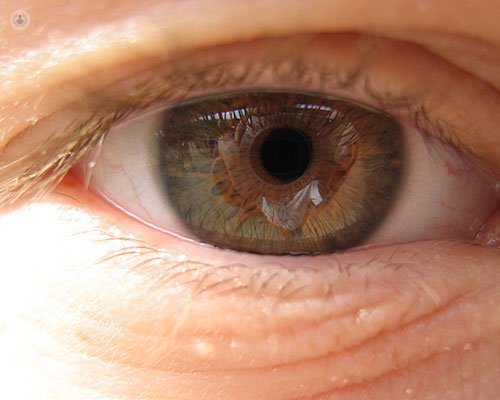Macular hole: causes, symptoms and treatment
Written by:A macular hole is a defect or rupture of tissue in the eye, located in the central area of the macula, called the fovea, which causes a central vision defect (scotoma) or a blurred zone in the centre of the visual field. The macula is the anatomical structure of the retina responsible for central vision, which we use when reading, watching TV or recognising faces. In his latest article, leading consultant opthalmologist Mr Serafeim Antonakis explains macular hole in detail.

What are the causes of macular hole?
Although they usually appear with age, macular holes can also be caused by eye trauma.
Ageing causes a degeneration of the vitreous humour which is attached to the retina by millions of miniscule fibres. As the vitreous humour contracts with age it pulls away from the retina – known as a detached retina.
There is extra tension on the retina and holes can form in the macula. The hole can fill with vitreous fluid, causing the vision to be blurred and distorted.
Who is most at risk of macular hole?
Older people are most at risk of macular hole, but it also occurs in patients with myopia greater than six dioptres, patients with ocular trauma and patients who have had a macular hole in their other eye (10-15% higher risk).
Are there different types of macular hole?
There are mainly two types of macular holes: complete macular holes and lamellar macular holes.
In the first case, a complete macular hole affects all layers of the retina and leads to greater loss of vision. With a lamellar macular hole, only a few layers of the retina are affected and therefore not so much vision is lost.
Lamellar macular holes may also be associated with epiretinal membranes.
What are the symptoms of a macular hole?
Symptoms related to the macular hole begin gradually. In the early stages the vision is slightly distorted or there is fog in the centre of the vision.
As the macular hole evolves, vision worsens and straight lines appear and there is a notable loss of reading ability. Vision deteriorates until it becomes very difficult to perform any central vision task with the affected eye.
How is macular hole treated?
It is crucial to have a complete ophthalmologic examination, including the following tests:
- retinography
- fundus autofluorescence imaging
- optical coherence tomography
- microperimetry test.
Although in the early stages some macular holes may close on their own, the vast majority of cases require microsurgery.
What does macular hole surgery entail?
The surgical procedure consists of a posterior vitrectomy to remove the vitreous gel from within the eye, removal of the posterior hyaloid and dissection and/or extraction of an extremely thin membrane called the internal limiting membrane to facilitate the relaxation of the retina so that the lips of the macular hole can settle back onto the pigment epithelium.
The eye is then filled with gas so that it maintains a pressure on the retina which allows the macular hole to close. Macular hole surgery is performed under local anaesthetic and the patient can return home after the procedure.
Mr Serafeim Antonakis is a renowned consultant ophthalmologist based in Southampton, Exeter & Fareham. If you would like to book a consultation with Mr Antonakis, you can do so today via his Top Doctors profile.


